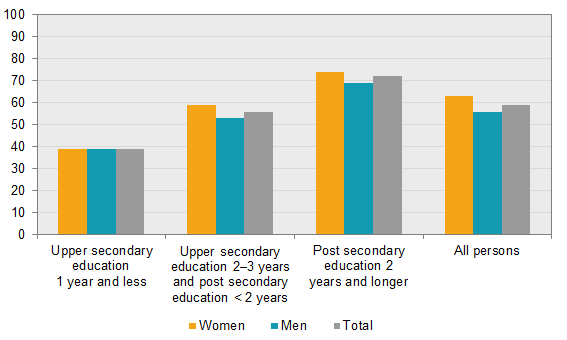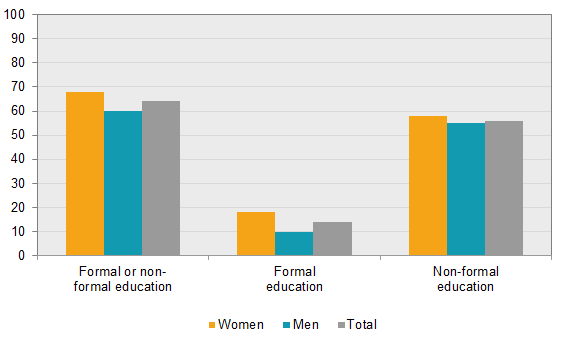Adult participation in education 2016:
Six out of ten employed persons took part in staff training
Statistical news from Statistics Sweden 2018-02-26 9.30
Six out of ten employed persons aged 25–64 took part in staff training during a twelve-month period between 2015 and 2016. Staff training was most common among highly educated persons, and thereby also in occupational groups that require university studies. Three out of four participants consider that the staff training activity was useful to a large or fairly large extent within 12 months.
These statistics are presented in a report produced by Statistics Sweden, in which adult participation in different types of education was reviewed through the Adult Education Survey.
More women took part in staff training
Among those who were employed, the proportion of women who took part in staff training over a twelve-month period was higher than the proportion of men. Among employed women, 63 percent took part in at least one staff training activity, compared with 56 percent among employed men.
Employed persons, aged 25–64. Percent

The percentage of those who took part in staff training increased with their educational level. This applied to both women and men. The most common reason for taking part in staff training was by far to be able to better carry out their job. About 75 percent of training activities were useful to a large or fairly large extent within 12 months.
Two out of three adults took part in education
Among adults aged 25–64, about 64 percent took part in training during a twelve-month period. Women took part to a larger degree than men, and non-formal education is more commonly occurring than formal education. It is not surprising that many people take part in non-formal education, as 80 percent of these training programmes consist of staff training.
The level of participation among adult women and men does not differ with regard to non-formal education. With regard to formal education, there is a difference between the sexes, as 18 percent of women and 10 percent of men took part.
Adults 25–64 years. Percent

About 80 percent of adults aged 25–64 have conducted self-study, also known as informal learning. This type of learning supplements formal and non-formal education. The most common type of self-study is done via a computer, tablet or smartphone.
Definitions and explanations
The Adult Education Survey is a sample survey carried out throughout the European Union every five years since 2006. The main questions concern staff training and other types of education. The questions were:
- What are the characteristics of persons participating in different types of education?
- What are the most common fields of education?
- What is the extent of different types of education, measured in number of participants and training hours?
- What are the effects and uses of different types of education?
- What language skills are there in the Swedish population?
Publication
A more detailed presentation of the survey is published in the theme report Adult participation in education – staff training and other types of education, which also includes results from the Continuing Vocational Training Survey.
Feel free to use the facts from this statistical news but remember to state Source: Statistics Sweden.
